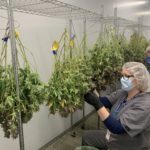Cannabis cultivation is expanding across the nation after the legalization of hemp and as states continue to legalize for medical or adult use. We are seeing this trend worldwide. The global cannabis market is expected to grow at a compound rate of 26.7% over the next 7 years. Any industry growing at that rate will have not only economic but environmental impact, as well. Fortunately, responsibly cultivated cannabis, especially hemp, positively impacts the environment in many ways.
Cannabis or hemp, sometimes referred to as “weed”, actually does grow like one. It crowds out other plants and it’s taproot holds the soil, channeling moisture into it. It can be widely grown in poor soil without pesticides or fertilizer and requires one-third the amount of water as cotton. Hemp can grow 13 feet in 100 days and produce as much in 90 days as a tree can produce in 20-30 years.
Hemp’s Potential Impact
Preservation of our forests has been a longtime concern. At this time, 90% of the world’s paper is made from trees and 60% of the world’s forests are cut for timber. Hemp can be manufactured into many products replacing wood and petroleum based products such as plastics and construction materials and even into clean burning bio-fuel that is 97% more efficient than gasoline. Hemp plastic bottles degrade 10 days after being discarded. Manufacturing products made of hemp instead of trees can eliminate the need to clear-cut forests. Paper mills are one of the largest contributors of the deadly chlorine compound, Dioxin, to the Great Lakes. One acre of hemp provides more than 4 times the amount of paper pulp than one acre of trees and can be harvested 2-3 times annually. In addition, a study by the USDA Forest Service found that all fine paper products currently made from wood could be made from hemp with minimal environmental impact and at a profit.
Hemp absorbs carbon through photosynthesis, stores it and returns it to the Earth while releasing high levels of oxygen. Industrial hemp has been proven to absorb more carbon dioxide per hectare than any forest or agricultural crop. The growth rate of cannabis makes it one of the fastest biomass conversation tools available today.
Regenerating Soil
The direct impact of the plant on the environment doesn’t stop with air quality. It’s root system is strong enough to break compacted soil, it increases soil quality and stabilizes the ground, controlling erosion. Cannabis cultivation actually regenerates soil through the process of phytoremediation, replenishes it and makes it possible to grow products in areas where crops were previously unfit for consumption. Hemp is one of the best phytoremediation plants known to man. Studies have shown industrial hemp’s effectiveness and ability to withstand high levels of heavy metals without affecting growth, harvest or quality. It’s well known to reduce levels of nitrogen, cadmium, strontium and cesium in soil. It has been used in Italy on land poisoned by one of Europe’s largest steel mills and in the Ukraine and near Chernobyl to counteract radioactive soil.
The Value of Hemp in Agriculture
Hemo’s value in agricultural soil remediation has an even more widespread application. Farmland that has been depleted by overuse or chemicals can be replenished by regularly rotating hemp with other crops while increasing the amount harvested. Hemp grown in rotation with wheat showed a 20% increase in wheat yield and rotated with soybeans reduced the chances of nematode infestation by 50-70%. Until the late 1800’s, it was one of the world’s largest agricultural crops.
It’s clear that the cultivation of cannabis has many advantages for our environment. But is that always the case? Recent research shows that although outdoor cultivation provides excellent solutions to many of today’s environmental issues, indoor cultivation may come with a hefty environmental consequence. Indoor growers must be vigilant to control the conditions of their grow. Depending on climate and other conditions, energy use will vary to control the temperature, humidity, air circulation and feeding.
Cannabis’s Carbon Footprint
The carbon footprint can be significant. In places such as Hawaii, it can take the equivalent to a 16-gallon tank of gas to produce 1oz of indoor grown cannabis. In Colorado, the cannabis industry’s carbon footprint exceeded those of the state’s coal mining industry. Estimates show that switching to outdoor cultivation would reduce greenhouse gas emissions by 96% and switching to greenhouses would reduce emissions by 42%. Federal, state and local laws are contributing to the problem by prohibiting transport of cannabis across state lines and placing unreasonable restrictions on outdoor cultivation. As these laws change, the carbon footprint from indoor cultivation will decrease as people regain the right to grow in areas that are conducive to year-round cultivation and transport their harvest much like other crops.
It’s through these legislative changes that real environmental progress will be made. The 2018 Farm Bill was a tremendous start to healing our environment and as the manufacturing industry of industrial hemp grows, the positive impact on the environment will grow as well. Legislative changes are still needed, to allow for outdoor cultivation and legal transportation between states. It’s rare for a burgeoning industry to have such a positive effect overall but cannabis has once again defied the odds and debunked the negative stigma that was pushed upon it years ago.
Want to learn more about cannabis and climate change? The Cleveland School of Cannabis now offers course in both Cannabis Horticulture and Industrial Hemp and CBD.






